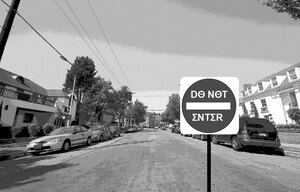28th Street closure could cause headaches
To close or not to close? That is the question — or is it?
Recently, Greek senators in the Undergraduate Student Government decided to re-examine a past proposal that would effectively close off 28th Street to automobile traffic, with the exception of Department of Public Safety vehicles and emergency transportation.
The pitch for a blockade of the Row would either see a partial closure at the Figueroa Street side of 28th Street or a full closure with fraternity and sorority houses sandwiched in by kiosks or some alternative means of enclosure (for example, small scale replicas of the Great Wall).
On the surface, it seems like this is a no-brainer:
People drink on the Row. Drunk people meander into streets. Cars drive on streets.
And despite what any inebre-hero will tell you, the battle between man and machine is never fair.
So eliminating cars driving through streets haphazardly occupied by the undergraduate student body decreases the probability of accidents dramatically.
Simple enough, no?
It would be foolish to argue that the proposed measure does anything but improve the safety of those traveling up and down the Row on any given night. While there have luckily not been any incidents on the densely populated strip this year, there have been instances of accidents in the past. A move to close the Row helps increase peace of mind by promoting safety with the prevention of automotive traffic and outside entry.
The question then, is not a matter of whether or not the closure should happen, but how exactly the closure should happen, assuming it passes the many bureaucratic hurdles.
The first issue arises in the difference between full closure and partial closure.
Realistically, for emergency vehicles to be able to easily access all houses on 28th Street in an efficient manner, there could not be a full closure using permanent blockades. But by only employing a partial closure, it would be rather difficult to try and enforce the no-through-traffic rule to other cars.
Not to mention there has been no discussion as to what would happen with regards to University Avenue, which runs perpendicular to the Row and splits it in half. One can only assume that if both ends were closed off, University Avenue would also have to be cut off, for fear of undermining the efforts of the proposed closure.
But think of the headaches that would result from having added a new series of dead-end roads around the perimeter.
Let’s say that there is a way to close off through traffic on 28th Street completely and that there exists some means of entry for emergency and DPS vehicles.
Win-win situation, right?
Not quite.
Contrary to popular belief, there are people that actually live in the same fraternity house that your friend graciously puked at last weekend. The concept is abstract to some — like hearing that all the ride operators at Disneyland go to sleep at their respective attractions once the park is shut down for the night.
Although the spirit of the proposal seems to focus on minimizing the risk of injury to students partaking in the nightlife offered by the Greek community, it poses many further potential complications for those who reside on the Row during its tamer, off hours.
Finding a prime parking spot on the Row is like finding an extra chicken nugget in your four-piece order. But while parking is scarce, especially on street cleaning days and during some philanthropy events, it still exists. Closing off 28th Street to through traffic would eliminate dozens of parking spaces.
Many fraternity and sorority houses have parking lots in the backs of their properties that are accessible by back alleyways on either side of the Row. But even the biggest lots can only accommodate a fraction of the membership.
And by closing off the Row, what happens to the street cleaning that takes place regularly?
Mind you, this is not a case of a spoiled member of the Greek system who doesn’t want any part of cleaning up his own mess.
Each house should be responsible for the maintenance of its property. But if an army of red cups and scattered Del Taco wrappers start to accumulate thanks to efforts from non-Greek partygoers, they will continue to reside in the middle of the street up until it gets unbearable. It’s not unreasonable to think the Row could get much messier.
Making the Row an enclave in the off-campus area (Row Island, if you will) seems to be a very attractive and sound safety plan. But in taking a look at logistical concerns, it shouldn’t surprise anyone that what seems like a common sense solution has not already been implemented.
Ultimately, 28th Street should be closed off to outside traffic in the interest of safety and reduced liability, but not before there’s a way to figure out how to accommodate those that live on the Row.
Soojin Yoon is a junior majoring in public relations and a member of Sigma Phi Epsilon fraternity. His column, “Boy Meets Word,” runs Thursdays.

